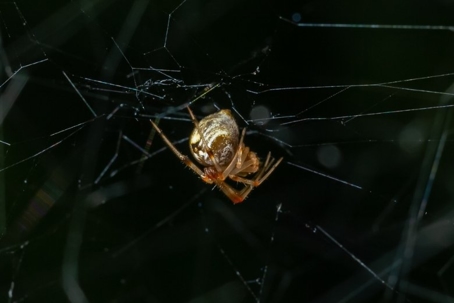Can Cobweb Spiders Bite?
Yes, cobweb spiders can bite, but it’s very uncommon. “Cobweb spiders” typically refers to spiders in the Theridiidae family, which includes the common house spider as well as some more notorious species like black widows. Most cobweb spiders are small, non-aggressive, and their fangs are not strong enough to penetrate human skin easily. Bites usually occur only if the spider is trapped against the skin, such as when someone rolls onto it in bed or handles it roughly.
Do Cobweb Spiders Bite?
Cobweb spiders are generally non-aggressive and avoid humans and pets, so bites are rare. When bites do occur, it’s usually because the spider feels threatened or trapped. Key situations include:
Accidental contact: Rolling onto a spider in bed or brushing against one while reaching into a corner, closet, or storage area. Disturbing a web that the spider is resting in.
Handling spiders directly: Trying to pick up or move the spider by hand. Crushing it accidentally, which triggers a defensive bite.
Pets disturbing webs: Cats or dogs pawing at webs in corners, basements, garages, or attics can provoke defensive bites. Bites on pets are very rare because most house spiders are small and their fangs often cannot penetrate fur and skin effectively.
High spider density areas: Basements, sheds, garages, or cluttered storage spaces where spiders are concentrated. When spiders feel cornered due to human activity in their habitat.
Cobweb spider bites are almost always defensive, not predatory. Most cobweb spiders prefer to retreat rather than bite.
Cobweb Spider Bites
For most cobweb spiders—the small, non-venomous types commonly found in homes—the risks from a bite are minimal. They are largely annoying rather than dangerous:
Minor irritation (most common)
Redness or a small raised bump at the bite site
Itching or mild discomfort
Slight swelling, usually localized
These symptoms typically resolve on their own within a day or two
Allergic reactions (rare)
Some individuals may have mild allergic responses to spider saliva
Symptoms can include increased redness, itchiness, or hives around the bite area
Severe allergic reactions are extremely rare but would require immediate medical attention if breathing difficulties or systemic symptoms occur
Bites from venomous cobweb spiders (rare)
Black widows are the primary cobweb spider species in the U.S. capable of medically significant bites. Potential risks from a black widow bite include sharp pain at the bite site, muscle cramps, spasms, or rigidity, abdominal pain and nausea, and sweating, tremors, or elevated blood pressure.
Severe cases are more likely in children, the elderly, or immunocompromised individuals
Fatalities are extremely rare with modern medical care
Secondary infection
Any spider bite that breaks the skin can become infected if not properly cleaned
Signs of infection include increased redness, warmth, pus, or worsening pain
Medical care may require topical or oral antibiotics if infection develops
Most cobweb spider bites are harmless, causing only minor irritation. The main medical concern comes from black widow bites, which are uncommon and usually only occur if the spider is threatened or trapped.
What Do Cobweb Spider Bites Look Like?
Cobweb spider bites are usually small and unremarkable, especially from the common non-venomous house spiders. Appearance varies depending on the species, individual reaction, and whether the spider is venomous:
Bites from non-venomous cobweb spiders (most house spiders)
Small red bump, similar to a mosquito bite
Slight swelling around the bite site
Mild itchiness or tenderness
Sometimes a tiny puncture mark is visible in the center
Usually heals within a day or two without complications
Bites from venomous cobweb spiders (black widows)
Two small puncture marks from the fangs, often close together
Localized redness and swelling at the site
Pain is usually sharp or burning and may spread from the bite site
In some cases, a bluish or purplish area develops
Severe systemic symptoms can occur within hours, including muscle cramps, abdominal pain, sweating, or nausea
Bite site may remain tender for a few days, but tissue necrosis is rare
Secondary changes
Scratching can lead to further redness, minor bleeding, or crusting
Infection is uncommon but possible if the skin is broken and bacteria enter
Most cobweb spider bites are mild and self-limiting. Black widow bites are the exception, but they are rare and typically occur only if the spider is trapped or provoked.
What To Do About Cobweb Spider Bites
If you are bitten by a cobweb spider, the response depends on whether it’s a common house spider or a potentially venomous species like a black widow:
Immediate first aid
Clean the bite: Wash the area thoroughly with soap and water to prevent infection.
Control swelling: Apply a cold pack or clean cloth with ice for 10–15 minutes at a time.
Reduce discomfort: Over-the-counter pain relievers like acetaminophen or ibuprofen can help with pain or inflammation.
Avoid scratching: Scratching can break the skin and increase infection risk.
Monitor symptoms
For common house spider bites, watch for redness, small bump, mild swelling, or itching. Symptoms usually resolve within a day or two.
For black widow bites or if you suspect a venomous spider, watch for severe pain at the bite site, muscle cramps or spasms, especially in the abdomen or back, nausea, vomiting, sweating, or tremors. Seek medical attention immediately.
Seek medical attention if:
Bite shows rapid spreading redness, warmth, or pus, suggesting infection
You experience systemic symptoms like dizziness, cramping, or difficulty breathing
The spider is suspected to be venomous (black widow)
Prevention and follow-up
Keep the bite area clean and dry
Avoid irritating the site until it fully heals
Consider photographing the spider if possible to help medical professionals identify the species
Most cobweb spider bites are minor and self-limiting, but bites from black widows or allergic reactions require prompt medical attention.

